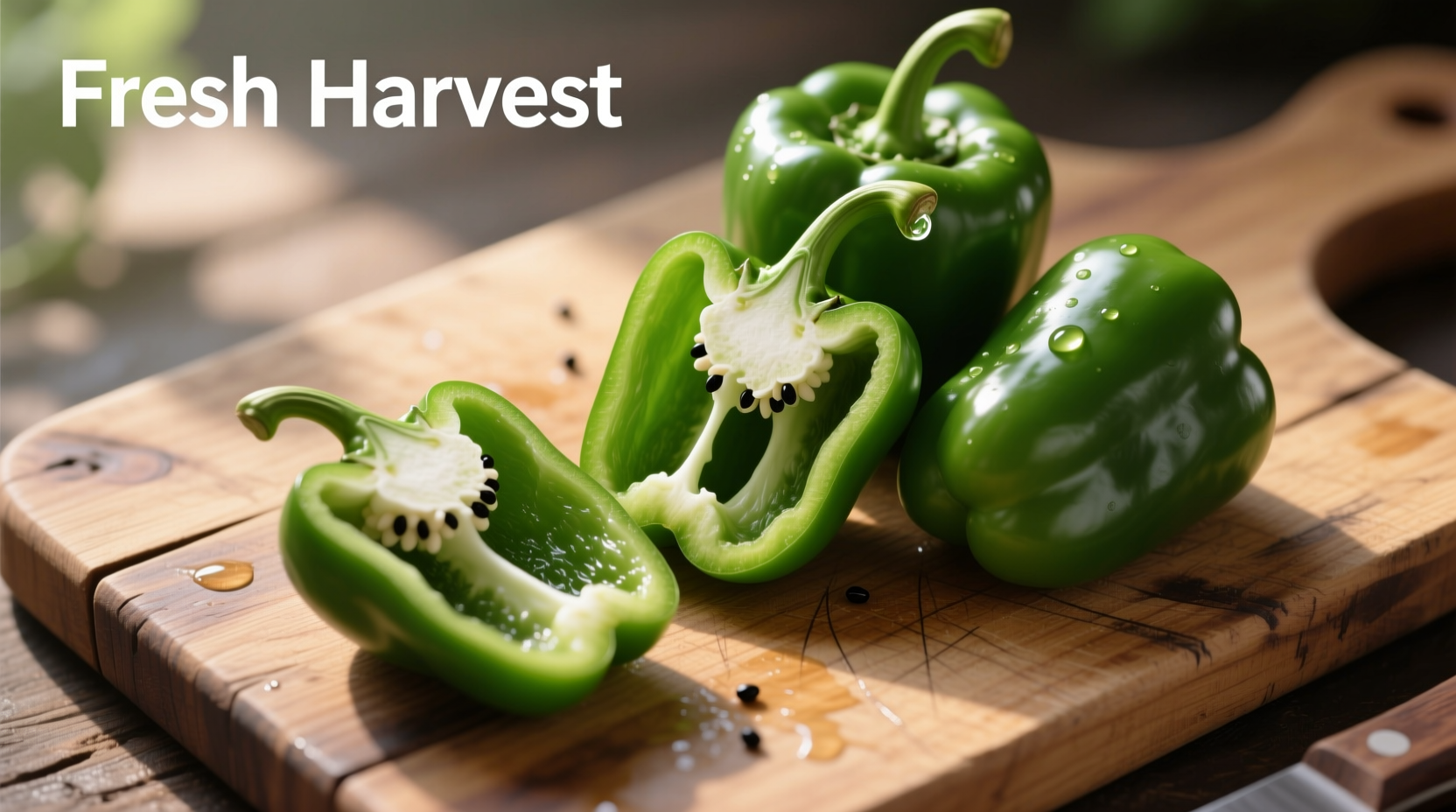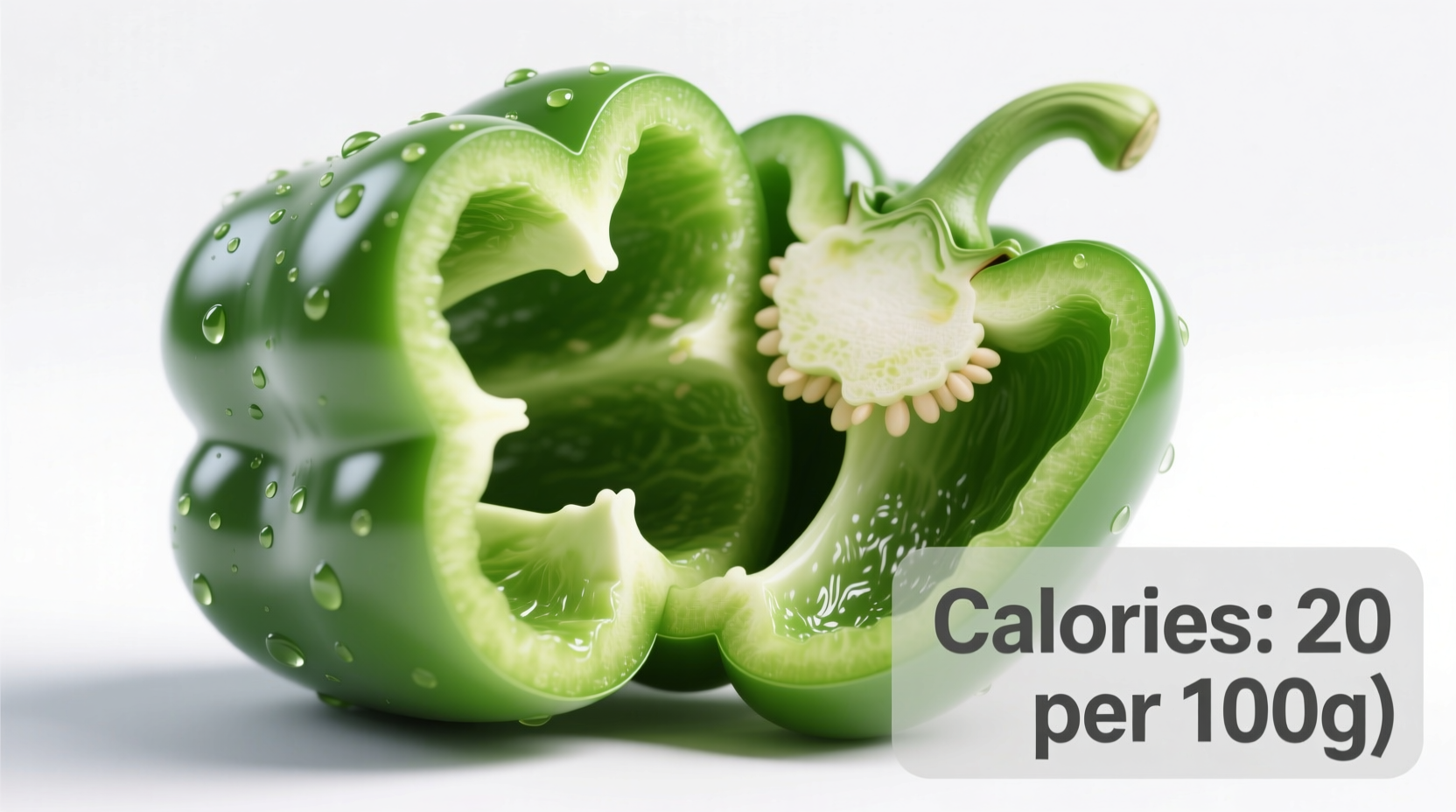One medium raw green bell pepper (approximately 119 grams) contains just 24 calories, making it an exceptionally low-calorie vegetable option for health-conscious eaters and those managing dietary needs.
Understanding the precise nutritional value of everyday vegetables helps you make informed dietary choices without sacrificing flavor or satisfaction. Whether you're tracking macros, following a specific diet plan, or simply aiming to eat more nutritiously, knowing exactly what's in your food matters.
Green Pepper Nutrition: Beyond Just Calories
While the calorie count is impressively low, green peppers offer much more nutritional value than many realize. According to the USDA FoodData Central database, a standard medium green bell pepper provides:
| Nutrient | Amount per Medium Pepper (119g) | Percent Daily Value |
|---|---|---|
| Calories | 24 | 1% |
| Total Fat | 0.2g | 0% |
| Carbohydrates | 5.8g | 2% |
| Dietary Fiber | 2.5g | 9% |
| Sugar | 3.2g | - |
| Protein | 1.2g | 2% |
| Vitamin C | 95mg | 106% |
| Vitamin A | 370IU | 7% |
| Vitamin B6 | 0.3mg | 15% |
| Potassium | 261mg | 6% |
This nutritional powerhouse delivers over 100% of your daily vitamin C needs in a single serving—more than an orange—while remaining extremely low in calories. The high fiber content also promotes satiety, making green peppers an excellent choice for weight management diets.
How Serving Size Affects Calorie Count
Calorie counts vary based on how much pepper you actually consume. Here's a practical breakdown for common serving sizes:
- 1 cup sliced raw green pepper (150g): 30 calories
- 1 small pepper (85g): 17 calories
- 1 large pepper (186g): 37 calories
- 1/2 cup cooked green pepper: 20 calories
When tracking your intake, remember that preparation methods significantly impact the final calorie count. Raw peppers maintain their lowest-calorie profile, while cooking methods can alter nutritional density.
Preparation Impact on Nutritional Value
How you prepare green peppers affects both their calorie density and nutrient availability. Understanding these context boundaries helps you maximize nutritional benefits:
Raw vs. Cooked: Raw green peppers preserve maximum vitamin C content, which degrades with heat exposure. However, cooking can increase the bioavailability of certain antioxidants like carotenoids.
Cooking Methods Compared:
- Steaming: Minimal nutrient loss, maintains low calorie count
- Stir-frying: Adds minimal calories if using small oil amounts
- Roasting: Concentrates natural sugars, slightly higher calorie density per volume
- Stuffed peppers: Can significantly increase calories depending on filling
According to research published in the Journal of Agricultural and Food Chemistry, brief cooking (3-5 minutes) preserves most nutrients while enhancing certain antioxidant compounds. For maximum nutritional benefit with minimal calorie impact, quick cooking methods are ideal.

Green Peppers vs. Other Common Vegetables
How do green peppers stack up against other popular vegetables? This comparison helps contextualize their nutritional value:
- Green peppers vs. carrots: Green peppers have fewer calories (24 vs 30 per medium vegetable) and more vitamin C
- Green peppers vs. cucumbers: Green peppers have slightly more calories but significantly more vitamins and fiber
- Green peppers vs. tomatoes: Similar calorie counts, but green peppers contain 3x more vitamin C
- Green peppers vs. red/yellow peppers: All colors have similar calorie counts, but red peppers contain 9x more vitamin A
Interestingly, green peppers are actually unripe versions of red, yellow, and orange bell peppers. As they ripen and change color, their sugar content increases slightly (adding about 5-10 calories) while vitamin content shifts—green peppers have the highest concentration of certain phytochemicals while red peppers develop more beta-carotene.
Health Benefits Beyond Calorie Counting
The value of green peppers extends far beyond their low-calorie profile. These versatile vegetables offer multiple health benefits supported by nutritional science:
Weight Management Support: With high water content (92%) and fiber, green peppers create volume in meals without adding significant calories—perfect for maintaining satiety during calorie-restricted diets.
Antioxidant Powerhouse: Green peppers contain lutein, zeaxanthin, and other antioxidants that protect against cellular damage. Research from the National Institutes of Health indicates regular consumption of pepper varieties correlates with reduced oxidative stress markers.
Digestive Health: The combination of fiber and water supports healthy digestion and regularity. One medium pepper provides nearly 10% of your daily fiber needs.
Blood Sugar Regulation: With a low glycemic load of just 2, green peppers won't cause blood sugar spikes, making them excellent for diabetes management diets.
Practical Ways to Enjoy Green Peppers
Incorporating green peppers into your diet doesn't require complicated recipes. Try these simple, calorie-conscious approaches:
- Add raw slices to sandwiches and wraps for crunch without extra calories
- Include in omelets or scrambled eggs for added nutrition
- Create colorful stir-fries with minimal oil
- Stuff with lean protein and whole grains for a balanced meal
- Blend into sauces and salsas for natural sweetness
For meal preppers, sliced green peppers maintain freshness for 3-4 days in airtight containers, making them convenient additions to weekly meal plans. Their versatility means they work equally well in Mediterranean, Asian, Latin American, and American cuisine.
Common Questions About Green Pepper Nutrition
Are green peppers suitable for keto diets? Absolutely. With just 3g net carbs per medium pepper, they fit comfortably within most ketogenic eating plans.
Do green peppers contain sugar? Yes, but naturally occurring sugars—about 3.2g per medium pepper—which is less than many fruits and contributes to their mild sweetness.
Can I eat green peppers if I'm watching my sodium intake? Raw green peppers contain virtually no sodium (less than 3mg per pepper), making them excellent for low-sodium diets.











 浙公网安备
33010002000092号
浙公网安备
33010002000092号 浙B2-20120091-4
浙B2-20120091-4